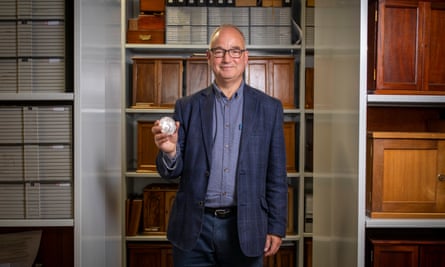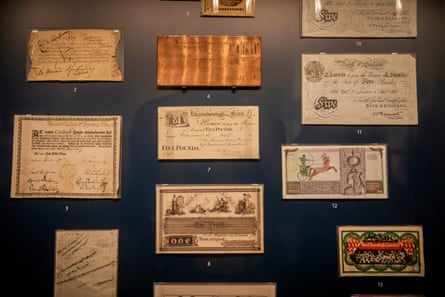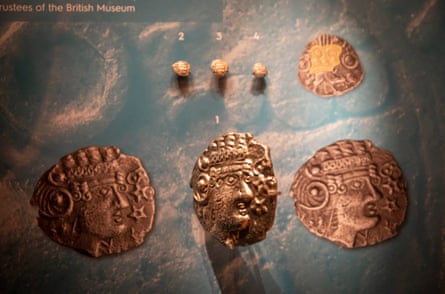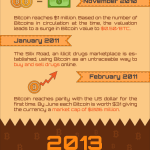Prof Chris Howgego carefully cradles the medal minted for the coronation of the boy king Edward VI in 1547 as he mulls over the history of money from Babylon to bitcoin.
“Everything depends on confidence,” says the keeper of the Heberden coin room at the Ashmolean museum in Oxford. “Coins are just one form of money. Anything that can be used as payment is money.”
Howgego cites Papua New Guinea as an example of what he means. Pearl shells were once used there as cash, which is why the word for shell – kina – is now the name of the national currency. He adds: “The Chinese once used rice as money – at least you could eat it!”
 View image in fullscreenProfessor Chris Howgego displays a coronation medal of Edward VI minted in 1547 and held in the Ashmolean Museum. Photograph: Alicia Canter/The Guardian
View image in fullscreenProfessor Chris Howgego displays a coronation medal of Edward VI minted in 1547 and held in the Ashmolean Museum. Photograph: Alicia Canter/The Guardian
Money is never really out of the news, but there has been even greater focus on it than usual in recent months. One reason is inflation, which has reappeared as a problem in the UK and other western countries for the first time in decades. One function of money is as a store of value, and a basket of goods and services that would have cost £100 a year ago costs £109 today.
The other reason is the debate over the security of digital currencies after the collapse of the “stablecoin” terra, and whether in fact cryptocurrencies are really money at all.
Q&A
What is a stablecoin?
Show
A stablecoin, like the name suggests, is a type of cryptocurrency that is supposed to have a stable value, such as US$1 per token. How they achieve that varies: the largest, such as tether and USD Coin, are effectively banks. They hold large reserves in cash, liquid assets, and other investments, and simply use those reserves to maintain a stable price.
Others, known as “algorithmic stablecoins”, attempt to do the same thing but without any reserves. They have been criticised as effectively being backed by Ponzi schemes, since they require continuous inflows of cash to ensure they don’t collapse.
Stablecoins are an important part of the cryptocurrency ecosystem. They provide a safer place for investors to store capital without going through the hassle of cashing out entirely, and allow assets to be denominated in conventional currency, rather than other extremely volatile tokens.
Was this helpful?Thank you for your feedback.
Stablecoins are supposed to maintain their value one for one against a non-digital currency – but terra suffered an old-fashioned bank run as investors tested whether it could stick to the peg.
Kristalina Georgieva, the managing director of the International Monetary Fund, made her feelings clear when speaking in Davos last month. “If a stablecoin is backed by assets one for one then it is stable. When it is not backed one for one but claims to give a 20% return, it is not stable – it is a pyramid that eventually collapses.”
 View image in fullscreenCoins from the early AD250s in the Ashmolean’s vault. Photograph: Alicia Canter/The Guardian
View image in fullscreenCoins from the early AD250s in the Ashmolean’s vault. Photograph: Alicia Canter/The Guardian
Andrew Bailey, the governor of the Bank of England, has said anybody investing in cryptocurrencies must be prepared to “lose all their money”, because they have no intrinsic value. That’s a view that Georgieva appears to share. “Bitcoin may be called a coin, but it is not money,” she said in Davos.
Ultimately, the banknotes printed by governments have no intrinsic value either, but are money because people accept them as such. Howgego says digital currencies challenge the idea that the only form of money is state-backed, with technology providing the backing instead of government guarantees.
 View image in fullscreenPaper money from around the world held at the Ashmolean museum. Photograph: Alicia Canter/The Guardian
View image in fullscreenPaper money from around the world held at the Ashmolean museum. Photograph: Alicia Canter/The Guardian
All forms of money until now, Howgego adds, have been about identity. He points out a coin found in a hoard of 5,000 Roman coins, which unearthed a hitherto unknown Roman emperor, Domitianus, from AD271. A soldier from northern Gaul, Domitianus proclaimed himself emperor, but didn’t last long. “Striking a coin was the equivalent of seizing a TV station in a modern coup. He probably only survived a few days, but had a coin struck during that time.”
Sign up to the daily Business Today email or follow Guardian Business on Twitter at @BusinessDesk
Cryptocurrencies are different in that anonymity is part of the appeal. The Edward VI coronation medal was all about announcing that the prince was now king, an example of what Howgego means when he says: “Coins are history in your hand.” That’s not the case with cryptocurrencies. “The point about bitcoin is the loss of identity.”
 View image in fullscreenTwo silver ‘Bury B’ units from circa 30BC, with enlarged replicas showing locks of hair and a hidden face. Photograph: Alicia Canter/The Guardian
View image in fullscreenTwo silver ‘Bury B’ units from circa 30BC, with enlarged replicas showing locks of hair and a hidden face. Photograph: Alicia Canter/The Guardian
Sheila Warren, of the Crypto Council for Innovation – an industry body – accepts that many of the new currencies will fail as part of a process of innovation and experimentation. She says cryptocurrencies are not just the preserve of wealthy investors, but are used for remittances where it is hard to transfer money across borders and for people who want to access a robust financial system without exorbitant cost.
Black people excluded from the traditional banking system, she says, can get loans through cryptocurrencies. “For rich people, crypto is about investment and speculation; for poor people, it is about basic financial services.”
Howgego says cryptocurrencies are an example of how money has evolved over time. His archive contains Roman hoards dug up in a field in Oxfordshire as it was being ploughed; an early example of Chinese paper money; a Noah’s Ark coin from Asia Minor; and what is thought to be one of the first examples of coinage, from Lydia in what is now western Turkey, from around 600BC. Money from imperial Roman mints was found as far east as Ukraine, India and along the silk road.
 View image in fullscreenProfessor Jerome Mairat demonstrates the Ashmolean’s new coin digitisation system. Photograph: Alicia Canter/The Guardian
View image in fullscreenProfessor Jerome Mairat demonstrates the Ashmolean’s new coin digitisation system. Photograph: Alicia Canter/The Guardian
The Ashmolean’s coin collection, which has 300,000 objects, is now being digitised so it can be accessed online, a painstaking process that the museum’s scholars say will revolutionise research. Curator Jerome Mairat says: “It is not easy with 300,000 items. We have digitalised 120,000 items in the past five years.”
The one big gap in the collection is the period after the Romans left Britain in the fifth century AD, because from around AD450 to AD600 there is no evidence of coins being used. “That’s why they are called the dark ages,” Howgego says. “We can’t tell what was being used as money.”


